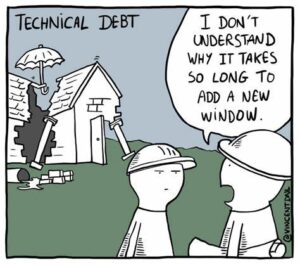In the dynamic world of software development, projects, like well-oiled machines, require regular cleaning, maintenance, and, most importantly, tune-ups.
Just as restaurants meticulously schedule kitchen maintenance and production lines periodically shut down for optimization, software projects demand attention to keep them running smoothly.
Defining Technical Debt
At the core of effective software project management lies the concept of technical debt. Imagine technical debt as the deferred tasks, defects, features, or activities consciously put aside to meet immediate project objectives. Technical debt can manifest in various forms, including a lack of automation, outdated libraries, poor development practices, inadequate code review, subpar architecture, and security vulnerabilities.
The challenge lies in striking a balance between addressing technical debt and meeting project delivery timelines for enhancements or new features/products.

The Consequences of Ignoring Technical Debt
Allowing technical debt to accumulate unchecked can lead to several adverse outcomes for organizations:
- Increased costs and difficulty developing new features or defect fixes
- Exposure to security vulnerabilities
- Reduction in the overall quality of the product
- Lower productivity for development teams
The impact of technical debt depends on an organization’s processes and maturity. While some organizations are proactive about managing technical debt, others may postpone addressing it until it becomes unavoidable. Unfortunately, the longer technical debt remains unresolved, it will become increasingly difficult and more expensive to resolve. Leaving technical debt unresolved will also impact future projects and efforts by adding scope and costs to projects.
Strategies for Handling Technical Debt
To effectively manage and prevent the accumulation of technical debt, consider the following strategies:
1. Get Organized
Just as epics, stories, and defects are tracked, technical debt should have its place in project management. Catalog work items in the same repository and label them accordingly. Prioritize technical debt alongside other work items to assess its impact and determine when to address it.
2. Be Proactive
Plan for technical debt and execute against that plan. Allocate dedicated time for teams to address technical debt—whether it’s a percentage of a sprint for smaller tasks or an entire sprint each quarter for more significant issues. Proactive planning ensures that technical debt is continually addressed without impeding regular project activities.
3. Automate All the Things
Automation is a powerful ally in managing technical debt. Commitment from the organization and investment in automation tools and practices are crucial. Implement:
- Reliable CI/CD pipelines
- A regression test suite
- Automated tests
- Automated dependency management (Dependabot, Renovate, etc.)
Leveraging automation allows a team to spend less time addressing technical debt and also creates a sense of confidence. When automated, a team member may only have to provide an approval because the heavy lifting was already completed via automation.
4. Listen to Your Staff
Pay attention to your engineers. If they’re voicing concerns about a system burdened with technical debt, their insights are valuable. Empower them to tackle technical debt, and you’ll likely see increased engagement and the development of a healthier system over time.
Engineering teams are constantly having pressure to execute. Demonstrating to the team that their insights and opinions are taken into account can yield a healthy and high-performing culture. Conversely, if a team is constantly asked to deliver features without the opportunity to address technical debt, this can lead to a non-performant product and a culture of ignoring issues.,which often leads to losing your best engineers.
Consider the impact on recruitment as well. Engineers prefer working with modern technology, and a system laden with technical debt may deter top talent from joining your organization, and if you’ve already lost some of your best engineers you can quickly get into a low performing culture. It’s a vicious cycle that can be difficult to get out of.
5. Don’t Let the Piles Become Mountains
Even with proactive strategies, technical debt will inevitably accumulate. Recording and prioritizing technical debt when identified ensures preparedness for addressing it when the time comes. Leveraging automated tools and processes makes resolving technical debt a manageable task rather than a daunting project.
In conclusion, effective management of technical debt is crucial for sustaining the health and productivity of software projects. By adopting a proactive approach, leveraging automation, and listening to the concerns of your development team, you can ensure that technical debt remains a manageable aspect of your project’s lifecycle. Remember, a well-maintained codebase is essential for long-term success in the ever-evolving landscape of software development.
Axian provides expert assistance with assessing and remediating technical debt.
Thank you for reading. If you have thoughts on this blog, would like to discuss the subject further, or learn more about our capabilities, please reach out!
